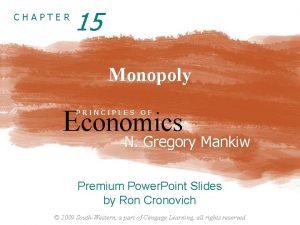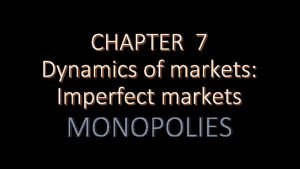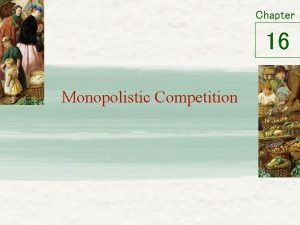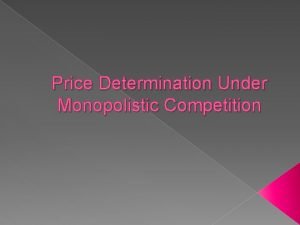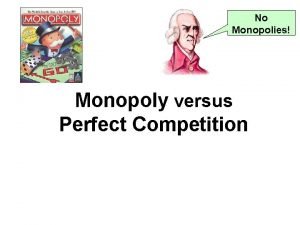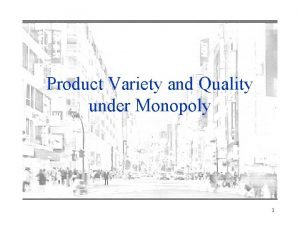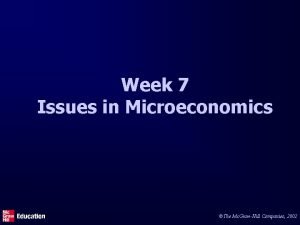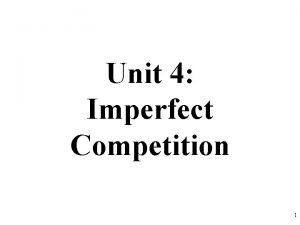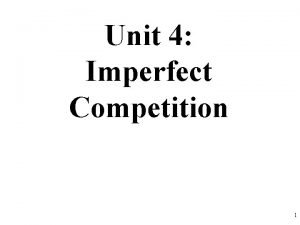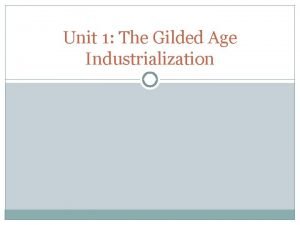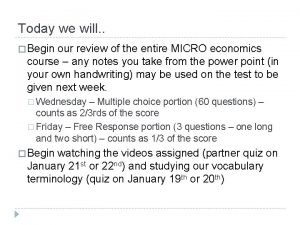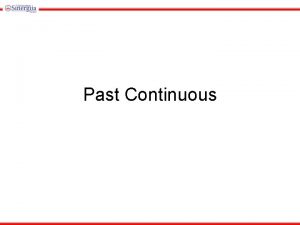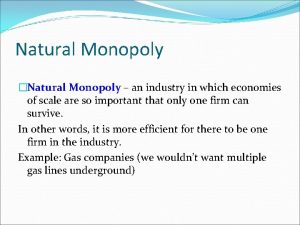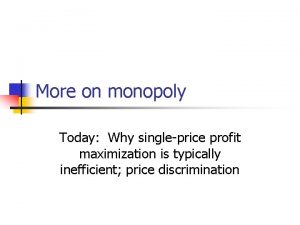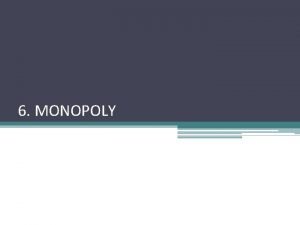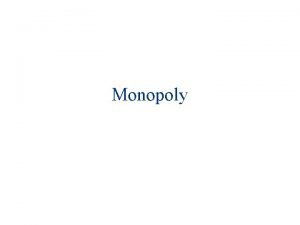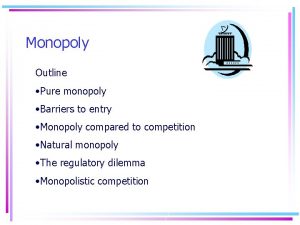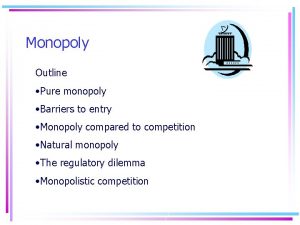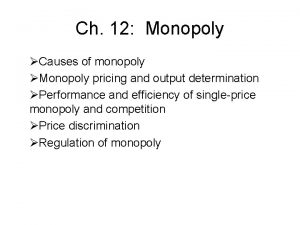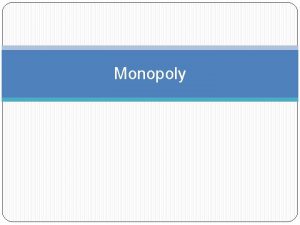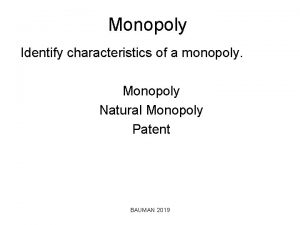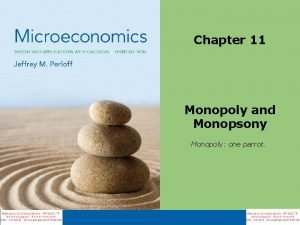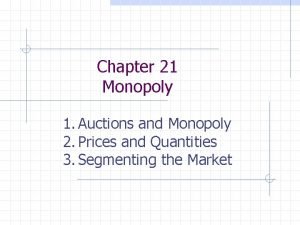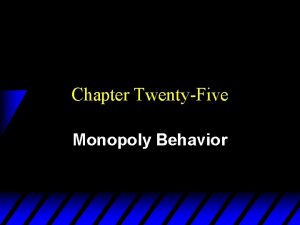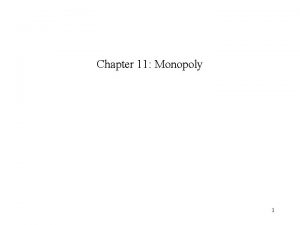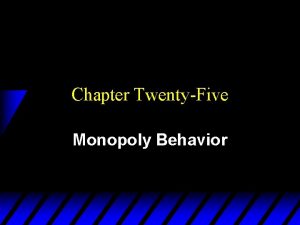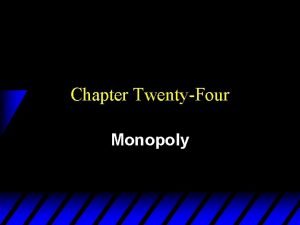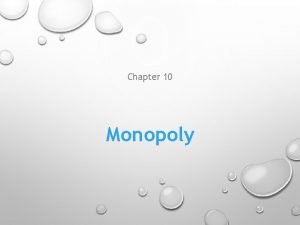Chapter 13 Monopoly 1 MONOPOLY AND HOW IT































- Slides: 31

Chapter 13 Monopoly 1

MONOPOLY AND HOW IT ARISES A monopoly is a market with a single firm that produces a good or service with no close substitutes and that is protected by a barrier that prevents other firms from entering the market. How Monopoly Arises Monopoly arises for two key reasons: No close substitutes Barrier to entry 2

MONOPOLY AND HOW IT ARISES No Close Substitutes If there is a close substitute, firm faces competition from producers of substitutes. A monopoly sells a good or service that has no close substitutes. Example: for drinking tap water and bottle water are substitutes. But for washing, shower, etc. tap water has no substitute. Public utility that supplies tap water is a monopoly. 3

MONOPOLY AND HOW IT ARISES Barrier to Entry A constraint that protects a firm from potential competitors is called a barrier to entry. The three types of barrier to entry are Natural Ownership Legal Natural Barrier to Entry A natural barrier to entry creates a natural monopoly: a market in which economies of scale enable one firm to supply the entire market at the lowest possible cost. E. g. , firms supplying gas, water and electricity. 4

MONOPOLY AND HOW IT ARISES • The market demand curve for Electricity power is D, and the long run average cost curve is LRAC. • Economies of scale prevail over the entire length of the LRAC curve. 5

MONOPOLY AND HOW IT ARISES Ownership Barrier to Entry An ownership barrier to entry occurs if one firm owns a significant portion of a key resource. Example: De Beers controlled up to 90% of the world’s supply of diamonds. Legal Barrier to Entry A legal barrier to entry creates a legal monopoly: a market in which competition and entry are restricted by the granting of a public franchise, government license, patent or copyright. 6

MONOPOLY AND HOW IT ARISES A public franchise is an exclusive right granted to a firm to supply a good or service. Example: U. S. Postal Service has exclusive right to carry first-class mail. A government license controls entry into particular occupations, professions and industries. Example: Medicine, law, architecture, etc. Licensing does not always create a monopoly but it does restrict competition. A patent is an exclusive right granted to the inventor of a product or service. 7

MONOPOLY AND HOW IT ARISES A copyright is an exclusive right granted to the author or composer of a literary, musical, dramatic, or artistic work. Patents and copyright are valid for a limited time that varies from country to country. Patents encourage the inventions of new products and production methods. They also stimulate innovations. Example: Innovations in pharmaceuticals, video games. Monopoly Price-Setting Strategies A major difference between monopoly and competition is that monopoly sets its own price. 8

MONOPOLY AND HOW IT ARISES The monopoly faces a market constraint: To sell a larger quantity, the monopoly must set a lower price. There are two monopoly situations that create two pricing strategies: Single Price Discrimination Single Price A single-price monopoly is a firm that must sell each unit of its output for the same price to all its customers. 9

MONOPOLY AND HOW IT ARISES Price Discrimination When a firm practices price discrimination, it sells different units of a good or service for different prices. Example: Computer manufacturers sell software at different prices to different customers. When a firm price discriminates it charges the highest possible price for each unit and makes the highest possible profit. 10

A SINGLE-PRICE MONOPOLY’S OUTPUT AND PRICE DECISION To understand how a single-price Monopoly makes its output and price decision, we study link between price and marginal revenue. Price and Marginal Revenue In monopoly there is only one firm demand curve of firm is the market demand curve. 11

A SINGLE-PRICE MONOPOLY’S OUTPUT AND PRICE DECISION 12

A SINGLE-PRICE MONOPOLY’S OUTPUT AND PRICE DECISION 13

A SINGLE-PRICE MONOPOLY’S OUTPUT AND PRICE DECISION At each level of output marginal revenue is less than price – the marginal revenue curve lies below the demand curve. Why is marginal revenue less than price? When price is lowered, two opposing forces affect total revenue. 1. 2. Lower price Revenue Loss Increased Quantity Revenue Gain 14

A SINGLE-PRICE MONOPOLY’S OUTPUT AND PRICE DECISION Marginal Revenue and Elasticity A single-price monopoly’s marginal revenue is related to the elasticity of demand for its good. The demand for a good can be Elastic Inelastic Unit Elastic Price and Total revenue Elastic P, TR MR is positive Inelastic P, TR MR is negative 15

A SINGLE-PRICE MONOPOLY’S OUTPUT AND PRICE DECISION 16

A SINGLE-PRICE MONOPOLY’S OUTPUT AND PRICE DECISION Is Monopoly, Demand is always elastic A profit-maximizing monopoly never produces an output in the inelastic range of the demand curve. Price and Output Decision A monopoly sets its price and output at the levels that maximize economic profit. To determine this price and output level, we study the behavior of both cost and revenue as output varies. 17

A SINGLE-PRICE MONOPOLY’S OUTPUT AND PRICE DECISION Maximize Economic Profit TR and TC both rise as output increases. But, TC rises at an increasing rate and TR rises at a decreasing rate. Economic profit increases at small output levels, reaches maximum and then decreases. Marginal Revenue Equals Marginal Cost When MR > MC Profit increases if output increases When MR < MC Profit increases if output decreases When MR = MC Profit is maximized 18

A SINGLE-PRICE MONOPOLY’S OUTPUT AND PRICE DECISION 19

A SINGLE-PRICE MONOPOLY’S OUTPUT AND PRICE DECISION 20

A SINGLE-PRICE MONOPOLY’S OUTPUT AND PRICE DECISION Maximum Price the Market will Bear Unlike perfect competition, a monopoly can influence price. But, a monopoly doesn’t charge the maximum possible price. At maximum possible price, firm will be able to sell only one unit of output which is less than profit-maximizing quantity. Rather, a monopoly produces the profit maximizingquantity and sells that for the highest price it can get. All firms maximize profit at MR = MC For a perfectly competitive firm, P=MR, so P=MC For a monopoly, P > MR, so P > MC. 21

A SINGLE-PRICE MONOPOLY’S OUTPUT AND PRICE DECISION A monopoly charges price higher than marginal cost but does it always make an economic profit? If a firm in perfect competition earns economic profit, then new firms enter. But, in monopoly barriers to entry prevents new firms from entering, so monopoly can earn economic profit indefinitely. In our example, Bobbie’s landlord increases rent, so her fixed cost increases. MR and MC remains unchanged. So, if this situation were permanent Bobbie would go out of business. 22

SINGLE-PRICE MONOPOLY AND COMPETITION COMPARED Comparing Price and Output Figure 13. 5 shows the market demand curve is D. The demand curve is same regardless of how the industry is organized. But the supply side and equilibrium are different in monopoly and competition. Perfect Competition Initially, market supply curve of perfect competition is S. In perfect competition, equilibrium occurs where demand supply curves intersect. Price is Pc and quantity is Qc 23

SINGLE-PRICE MONOPOLY AND COMPETITION COMPARED 24

SINGLE-PRICE MONOPOLY AND COMPETITION COMPARED Monopoly Suppose, the industry is taken over by a single firm. Consumers do not change, so market demand curve remains the same. But now the monopoly recognizes this demand curve as a constraint on the price at which it can sell its output. The monopoly’s marginal revenue curve is MR. Monopoly maximizes profit at MR=MC. The competitive market’s supply curve is the monopoly’s marginal cost curve. The profit-maximizing output is QM. 25

SINGLE-PRICE MONOPOLY AND COMPETITION COMPARED Q M < Q C Monopoly’s price is PM and PM > PC. We have established that Compared to a perfectly competitive market, a single-price monopoly produces a smaller output and charges a higher price. Efficiency Comparison Perfect competition is efficient. D= MSB, consumers are efficient. S = MSC, producers are efficient. 26

SINGLE-PRICE MONOPOLY AND COMPETITION COMPARED 27

SINGLE-PRICE MONOPOLY AND COMPETITION COMPARED In competitive equilibrium, marginal social benefit equals marginal social cost. Total surplus (consumer surplus and producer surplus) is maximized. Firms produce at lowest possible long-run average cost. Monopoly is inefficient. The smaller output and higher price drive a wedge between marginal social benefit and marginal social cost and create a deadweight loss. 28

SINGLE-PRICE MONOPOLY AND COMPETITION COMPARED Magnitude of deadweight loss is a measure of the inefficiency of the monopoly. Consumer surplus shrinks for two reason 1. 2. Higher Price – Monopoly gets higher producer surplus Lower output – Deadweight loss Although, monopoly gains from higher price, it also loses producer surplus from lower output. That loss is another part of deadweight loss. Monopoly doest not produce at lowest possible long-run average cost. 29

SINGLE-PRICE MONOPOLY AND COMPETITION COMPARED Monopoly damages consumer interest in three ways: Produces less Increases cost of production Raises the price by more than increased cost of production. Redistribution of Surpluses Monopoly is inefficient because it leads to deadweight loss – a social loss. But monopoly also brings a redistribution of surpluses. Monopoly takes the difference between the higher price, PM and the competitive price, PC on the quantity sold, QM. 30

SINGLE-PRICE MONOPOLY AND COMPETITION COMPARED Rent Seeking Social cost of monopoly can exceed the deadweight loss because of an activity called rent seeking. Any surplus – consumer surplus, producer surplus, or economic profit – is called economic rent. The pursuit of wealth by capturing economic rent is called rent seeking. Monopoly converts consumer surplus into economic profit. So the pursuit of economic profit by monopoly is 31
 Chapter 15 monopoly
Chapter 15 monopoly Monopoly outcome
Monopoly outcome Difference between monopoly and monopolistic competition
Difference between monopoly and monopolistic competition Advantages of a monopoly
Advantages of a monopoly Difference between perfect competition and monopoly market
Difference between perfect competition and monopoly market Example of pure competition
Example of pure competition Difference between perfect competition and monopoly
Difference between perfect competition and monopoly Difference between perfect competition and monopoly
Difference between perfect competition and monopoly Product variety and quality under monopoly
Product variety and quality under monopoly Price and output determination under monopoly
Price and output determination under monopoly P=mc
P=mc Difference between perfect competition and monopoly
Difference between perfect competition and monopoly Product variety and quality under monopoly
Product variety and quality under monopoly Price is greater than marginal cost in monopoly
Price is greater than marginal cost in monopoly Pure competition and monopoly _____
Pure competition and monopoly _____ Monopoly deadweight loss
Monopoly deadweight loss Social cost of monopoly
Social cost of monopoly Monopoly characteristics
Monopoly characteristics Social optimum quantity
Social optimum quantity Monopoly characteristics
Monopoly characteristics Standard oil monopoly
Standard oil monopoly Per unit tax monopoly
Per unit tax monopoly Perfect competition vs monopolistic competition
Perfect competition vs monopolistic competition Marginal revenue
Marginal revenue Mr=mc monopoly
Mr=mc monopoly Short run equilibrium under perfect competition
Short run equilibrium under perfect competition When you phoned i was working in the garden
When you phoned i was working in the garden Market structures venn diagram
Market structures venn diagram Unregulated monopoly
Unregulated monopoly Single price monopoly graph
Single price monopoly graph Barriers to entry in monopoly
Barriers to entry in monopoly Example of monopoly
Example of monopoly
